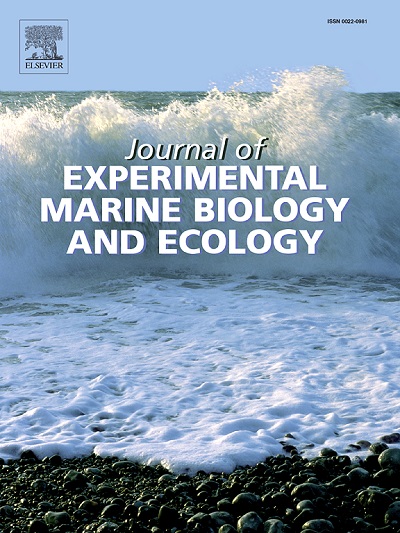Seafoam avoidance is driven by both chemosensory and contact cues and points towards the presence of soft-surface thigmotaxis in the intertidal gastropod Littorina littorea
IF 1.8
3区 生物学
Q3 ECOLOGY
Journal of Experimental Marine Biology and Ecology
Pub Date : 2025-02-01
DOI:10.1016/j.jembe.2025.152085
引用次数: 0
Abstract
Seafoam accumulation in coastal waters has long been acknowledged as ecologically, socially and economically relevant. However, its putative effects on the intertidal biota have been alarmingly under-researched despite the ubiquitous nature of onshore foam formation. This study examines the behavioural responses of the common periwinkle, Littorina littorea, exposed to two types of seafoam: a fresh seafoam (freshly formed) and an aged seafoam (collected after three hours of exposure in the field), using experimental assays carried out under controlled laboratory conditions. L. littorea consistently avoid seafoam, and exhibit a stronger aversion for fresh seafoam. They avoid crossing both seafoam, suggesting that contact cues play a crucial role in this avoidance behaviour. In this context, we introduce the concept of soft-surface thigmotaxis, by which L. littorea is able to follow soft physical discontinuities. Snails exhibited more tortuous movements and reduced speed before actually getting into physical contact with the fresh seafoam, suggesting that chemosensory influence foam avoidance, probably due to repellent volatile compounds requiring further identification. Observations suggest that snails show differential responses potentially influenced by variations in foam properties, such as phytoplankton content and the physical properties of the seafoam. Seafoam avoidance by L. littorea could have wider ecological implications by disrupting the snails' ability to find refuges, increasing their vulnerability to other environmental stresses. Investigating surfactants and pollutants in seafoam is crucial due to their toxicity to aquatic life. The study highlights the need for interdisciplinary research to fully understand and mitigate seafoam's effects on intertidal organism.
海洋泡沫的回避是由化学感觉和接触提示共同驱动的,这表明潮间带腹足动物Littorina littorea具有软表面趋动性
沿海水域的海泡沫积累长期以来一直被认为具有生态、社会和经济意义。然而,它对潮间带生物群的假定影响的研究却少得惊人,尽管陆上泡沫的形成无处不在。本研究考察了普通长春花Littorina littorea暴露于两种类型的海泡沫中的行为反应:新鲜海泡沫(新形成)和老化海泡沫(在野外暴露三小时后收集),使用在受控实验室条件下进行的实验分析。利托利亚始终不吃海泡,对新鲜海泡表现出更强烈的厌恶。它们避免穿越两个海浪,这表明接触线索在这种回避行为中起着至关重要的作用。在这种情况下,我们引入了软表面触致性的概念,通过这个概念,L. littorea能够遵循软物理不连续。蜗牛在实际接触新鲜的海水泡沫之前,表现出更曲折的运动和更慢的速度,这表明化学感觉影响了泡沫的避免,可能是由于驱虫剂挥发性化合物需要进一步鉴定。观察结果表明,蜗牛表现出不同的反应,可能受到泡沫特性变化的影响,例如浮游植物含量和海洋泡沫的物理特性。L. littorea对海浪的躲避可能会破坏蜗牛寻找避难所的能力,增加它们对其他环境压力的脆弱性,从而产生更广泛的生态影响。研究海水中的表面活性剂和污染物对水生生物的毒性是至关重要的。该研究强调了跨学科研究的必要性,以充分了解和减轻海浪对潮间带生物的影响。
本文章由计算机程序翻译,如有差异,请以英文原文为准。
求助全文
约1分钟内获得全文
求助全文
来源期刊
CiteScore
4.30
自引率
0.00%
发文量
98
审稿时长
14 weeks
期刊介绍:
The Journal of Experimental Marine Biology and Ecology provides a forum for experimental ecological research on marine organisms in relation to their environment. Topic areas include studies that focus on biochemistry, physiology, behavior, genetics, and ecological theory. The main emphasis of the Journal lies in hypothesis driven experimental work, both from the laboratory and the field. Natural experiments or descriptive studies that elucidate fundamental ecological processes are welcome. Submissions should have a broad ecological framework beyond the specific study organism or geographic region.
Short communications that highlight emerging issues and exciting discoveries within five printed pages will receive a rapid turnaround. Papers describing important new analytical, computational, experimental and theoretical techniques and methods are encouraged and will be highlighted as Methodological Advances. We welcome proposals for Review Papers synthesizing a specific field within marine ecology. Finally, the journal aims to publish Special Issues at regular intervals synthesizing a particular field of marine science. All printed papers undergo a peer review process before being accepted and will receive a first decision within three months.

 求助内容:
求助内容: 应助结果提醒方式:
应助结果提醒方式:


